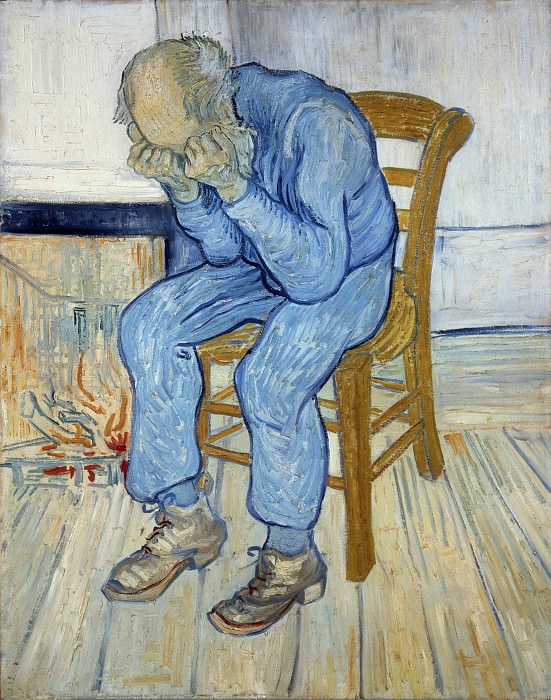Old Man in Sorrow Vincent van Gogh (1853-1890)
Vincent van Gogh – Old Man in Sorrow
Edit attribution
Download full size: 3305×4200 px (4,1 Mb)
Painter: Vincent van Gogh
Location: Kröller-Müller Museum, Otterlo.
Van Gogh has always been preoccupied with the theme of life. Its ephemerality, its fragility and at the same time its power. An unfortunate man, hardworking, persistent and refusing to give up hope even in the most hopeless situations, he has many times painted both despair and dream and the indomitable will to live, embodying it sometimes even in the most unobvious things like sunflowers. "On the Threshold of Eternity" is one of his rare paintings depicting man.
A description of Vincent van Gogh’s "On the Threshold of Eternity
Van Gogh has always been preoccupied with the theme of life. Its ephemerality, its fragility and at the same time its power. An unfortunate man, hardworking, persistent and refusing to give up hope even in the most hopeless situations, he has many times painted both despair and dream and the indomitable will to live, embodying it sometimes even in the most unobvious things like sunflowers.
"On the Threshold of Eternity" is one of his rare paintings depicting man. The first sketches for it were made in Etten, where Van Gogh sketched the locals, and where he met an old, seriously ill peasant, who eventually ended up on his canvas.
The painting shows the Old Man sitting on a chair near a fireplace. His whole posture expresses despair - his back is hunched, his hands clenched into fists covering his face, his elbows resting on his knees. He is clearly broken by some enormous grief, and around his figure and builds the entire composition of the picture, which, except for him, for the most part, and nothing.
There is a fireplace burning behind the grate - the flames are depicted schematically, with slight movements of the brush, without a hint of realism. The wooden floor is unpainted, while the walls are whitewashed. The chair beneath the peasant seems shaky, swaying, ready to throw him down at any moment.
Van Gogh is as detailed in his depiction of despair as he is in his depiction of happiness. The peasant’s shoes are splintered, they are already very old and one can see that they have been worn a lot in the mud and rain. The costume, despite the sketchiness of the image, looks shabby. The hair recedes, exposing a bald spot, the beard is neatly trimmed, and one can see that this man has lived a long life, during which, if he has seen happiness, it is rarely and only on holidays. Hard work, poverty, and now also illness.
And despite this, the picture looks strangely bright. As if even seeing the fear and pain, the artist does not want to part with the idea that life can still be beautiful and that hope - painful and simultaneously sweet - there is always.
Кому понравилось
Пожалуйста, подождите
На эту операцию может потребоваться несколько секунд.
Информация появится в новом окне,
если открытие новых окон не запрещено в настройках вашего браузера.
You need to login
Для работы с коллекциями – пожалуйста, войдите в аккаунт (open in new window).




















COMMENTS: 3 Ответы
Эта картина передаёт чувство отчаянья в полной мере
согласен с предыдущим комментарием.
как эта картина называется я чет не понял? "на пороге вечности" или "горюющий старик"?
You cannot comment Why?
The background is sparsely rendered, featuring a hearth with glowing embers on the left, suggesting a source of warmth that is juxtaposed with the coldness of the mans grief. The walls are a pale, muted color, and the floorboards are laid out in a simple, linear pattern. The overall color palette is dominated by blues and earthy browns, with the glowing reds of the fire providing a stark contrast.
The subtexts of the painting are rich and evocative. The title, Old Man in Sorrow, directly points to the central theme of the work: profound sadness and emotional suffering, likely stemming from the burdens of old age, loneliness, or past hardships. The obscuring of the mans face through his hands can be interpreted as a desire to withdraw from the world, to hide his pain, or perhaps an inability to confront his own anguish. The worn clothes and the humble setting speak to a life of hardship and perhaps poverty. The fire in the hearth, while a symbol of life and comfort, is shown as distant from the man, unable to penetrate his state of desolation. Van Goghs characteristic expressive brushstrokes contribute to the emotional intensity of the scene, imbuing the painting with a raw, palpable sense of human suffering and vulnerability.